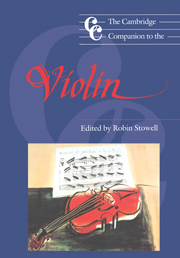Book contents
- Frontmatter
- 1 The violin and bow – origins and development
- 2 The physics of the violin
- 3 The violinists of the Baroque and Classical periods
- 4 The nineteenth-century bravura tradition
- 5 The twentieth century
- 6 The fundamentals of violin playing and teaching
- 7 Technique and performing practice
- 8 Aspects of contemporary technique (with comments about Cage, Feldman, Scelsi and Babbitt)
- 9 The concerto
- 10 The sonata
- 11 Other solo repertory
- 12 The violin as ensemble instrument
- 13 The pedagogical literature
- 14 The violin – instrument of four continents
- 15 The violin in jazz
- Appendix Principal violin treatises
- Glossary of technical terms
- Notes
- Select bibliography
- Index
13 - The pedagogical literature
Published online by Cambridge University Press: 28 September 2011
- Frontmatter
- 1 The violin and bow – origins and development
- 2 The physics of the violin
- 3 The violinists of the Baroque and Classical periods
- 4 The nineteenth-century bravura tradition
- 5 The twentieth century
- 6 The fundamentals of violin playing and teaching
- 7 Technique and performing practice
- 8 Aspects of contemporary technique (with comments about Cage, Feldman, Scelsi and Babbitt)
- 9 The concerto
- 10 The sonata
- 11 Other solo repertory
- 12 The violin as ensemble instrument
- 13 The pedagogical literature
- 14 The violin – instrument of four continents
- 15 The violin in jazz
- Appendix Principal violin treatises
- Glossary of technical terms
- Notes
- Select bibliography
- Index
Summary
Treatises
It was not until the end of the seventeenth century that instruction books devoted exclusively to violin technique were published, John Lenton's The Gentleman's Diversion … (1693) being recognised as the first extant violin tutor. Like most of its immediate successors, it was intended for the amateur musician. Its elementary content was no substitute for oral instruction by a teacher, on whom many depended in order to learn techniques ‘which may be knowne but not described’. Earlier in the century some treatises had begun to reflect both the liberation of instruments from their subordination to the voice and the improved social position of the violin itself by incorporating descriptions of contemporary instruments, sometimes with some basic technical information. But these were publications addressed to musicians as a whole, dealing with a wide range of instruments, and were not specialist violin texts. Among the most significant of these ‘multi-purpose’ volumes were Praetorius's Syntagma musicum (1618–20), Mersenne's Harmonie uni verselle (1636), Zanetti's Il scolaro … per imparar a suonare di violino, et altri stromenti (1645), Prinner's Musicalischer Schlissl (1677), Speer's Gründ-richtiger … Unterricht (1687) and Falck's Idea boni cantoris (1688). John Playford's A Brief Introduction to the Skill of Musick demonstrates the increasing popularity of the violin in amateur circles, a complete section, ‘Playing on the Treble Violin’, being added in a second revised edition (1658) published four years after the first.
- Type
- Chapter
- Information
- The Cambridge Companion to the Violin , pp. 224 - 233Publisher: Cambridge University PressPrint publication year: 1992



